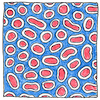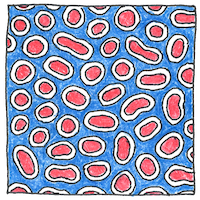Alan Turing
theoretical biology

|
Turing pattern
During morphogenesis, mathematical rules describe the generation of stripes, spots, spirals, hexagons, scales, and hairs. instability can be triggered by random disturbances Morphogens diffuse through cells, assuming biological functions, and forming waves of reactions. and may result in patterns in nature
Reaction-diffusion systems
How morphogenesis arises from homogeneity How combustion spreads across available fuels How blood and lymphatic vessels form in embryos How coats and colorations develop in animals How action potentials travel through nerves How biological populations spread How ecosystems are invaded by non-native species How tumors spread and wounds heal
Tractable patterns
When initial conditions are not homogeneous, or when multiple morphogenes operate in the same space and time simplifying assumptions make theoretical analysis tractable but our analysis is strengthened by the consideration that during the growth of an organism spatial patterns arise spontaneously.
Living patterns
The mind sees patterns in random noise. It’s what we do. An orderly routine takes less energy. Why live in chaos? Water, when freezing, releases heat, giving snowflakes.



Alan Turing presented differential equations to describe the ideal behaviors of systems with simplified geometries. How does pattern arise from homogeneity? Key factors are time and randomness.
See also in The book of science:
Readings in wikipedia: